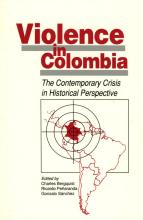A country that prides itself on having the most consistent democratic tradition in Latin America, Colombia also has experienced continual violence that makes it one of the most convulsed societies in the world. La Violencia (“The Violence”) is the term Colombians have adopted to describe in particular the terror, political banditry, pillage, and peasant uprising that the country lived through between the 1940s and the 1960s.
When did the Violence begin? Is it still an ongoing problem? The fourteen essays in this collection—written by leading international and Colombian social scientists and philosophers—comprise the first English volume to examine La Violencia, its historical antecedents, and the social unrest still plaguing Colombian society today.
While many consider Colombia’s woes to stem almost exclusively from its drug cartels, Violence in Colombia places this one important variable within a broader, balanced context. The contributors look at the role of significant factors such as the drug mafia, the guerrillas, the paramilitary right, agrarian and labor movements, class conflict, and economic development. They also suggest solutions involving reforms that will fundamentally change—and challenge—Colombian society.
